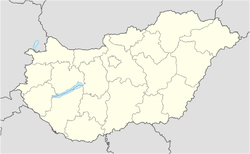| Main | Births etc |
|---|
| Kaposvár German: Ruppertsburg Turkish: Kapoşvar Slovene: Rupertgrad Croatian: Kapošvar |
|||
|---|---|---|---|
| — Town — | |||
| City Hall of Kaposvár, County Hall of Somogy, University of Kaposvár, Csiky Gergely Theatre, Cathedral of Kaposvár, Rippl-Rónai Villa and the statue of József Rippl-Rónai | |||
|
|||
| Location of Somogy County in Hungary | |||
| Coordinates: | |||
| Country | |||
| Region | Southern Transdanubia | ||
| County | Somogy | ||
| Subregion | Kaposvár | ||
| Government | |||
| • Mayor | Károly Szita | ||
| Area | |||
| • Total | 113.59 km2 (43.86 sq mi) | ||
| Elevation | 153 m (502 ft) | ||
| Population (1-1-2014) | |||
| • Total | 64 872 | ||
| • Density | 113.59/km2 (294.2/sq mi) | ||
| Time zone | CET (UTC+1) | ||
| • Summer (DST) | CEST (UTC+2) | ||
| Postal code | 7400 | ||
| Dialing code | 82 | ||
| Website | [www.kaposvar.hu www.kaposvar.hu] | ||
Kaposvár (Hungarian pronunciation: [ˈkɒpoʃvaːr]; German: Ruppertsburg, Turkish: Kapoşvar, Slovene: Rupertgrad, Croatian: Kapošvar) is a city in Somogy County. Southern Transdanubia Region in the southwestern part of Hungary, south from the Lake Balaton. It is one of the leading cities of Transdanubia and it is the capital of Somogy County. Kaposvár is the seat of the Roman Catholic Diocese of Kaposvár.
Etymology[]
The name of the city derives from the words "kapu" and "vár", meaning gate and castle in Hungarian. So Kaposvár is the "Castle of gates". Experts believe that it is possible that the city used to have many gates.
Coat of Arms[]
The shield of Kaposvár consists of the green hills which means the Somogy Hills and the three-towered castle with a huge metal gate. The Castle of Kapos could look like it.
Geography[]
The city is enclosed by the gentle knolls of the subregion called Outer Somogy on the north and by the bluff downhill forests of the other subregion Zselic on the south. Trade arrived by river, and the city also became a center of crossroads reaching into the region. Flood controls have been instituted on the river.
Nowadays Kaposvár is a developing junction for rail- and public roads; it is closely connected to all the settlements of the agglomeration, as well as to those over the knoll. The European railway line from Budapest towards the Mediterranean leads through Kaposvár and other cities of the county.
The city lies 186 km (116 mi) south‐west of Budapest, on both sides of the River Kapos on the Somogy Hills. The city is located about 50 km (31 mi) from the Lake Balaton (on the road 67), 62 km (39 mi) from Pécs (on the road 66), 40 km (25 mi) from Szigetvár (on the road 67), 92 km (57 mi) from Szekszárd (on the road 65) and 72 km (45 mi) from Nagykanizsa (on the road 61).
History[]
Before the Hungarian land-taking[]
According to legend, the city was founded on seven hills (like Rome). The area had already been inhabited by 5000 BCE. From around 400 BCE, Celtic tribes populated the area. From 9 AD to 107 AD the city belonged to the Roman Pannonia. In the subsequent years many people lived there. Mainly German and Illyrian tribes were in that place. In 900 the conquering Hungarians found Slavic and German villages in this land. After the conquest of the Hungarians the tribe of Koppány settled down in Somogy.
Middle Ages[]
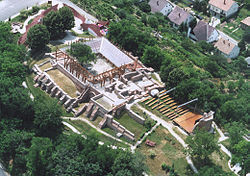
The Kaposszentjakab Monastery
The name of the settlement appeared first in 1009 as "Kapos", in Saint Stephen's memorandum of association, which fixed the borders of the Roman Catholic Diocese of Pécs. In 1061 Atha (Ottó), the lord lieutenant of Somogy founded a benedictine monastery, in which consecration King Salamon and Prince Géza took part. King Béla IV, after the Mongol invasion of Hungary, made built strong castles. Kaposvár's first castle was built during his reign in the years of 1200. Despite this, the monastery and considerable settlement around the castle didn't come into existence yet, one reason being because the settlement was avoided by the commercial roads and on the other hand because the different clans fight didn't favour the development. The rectangular motte castle was reconstructed as a stone castle in the 15th century.
Eventually, the period of local fighting was ended by the Turkish gunfire. In the decades after the Battle of Mohacs the neighbourhood was prowled by the troops of Suleyman. The Ottomans invested the castle of Kapos in September 1555 after a five-day siege. It was followed by a 131 year old Turkish occupation. During this time Kaposvár, despite being a small administrative center, worked rather as a military camp. Finally the Christian troops liberated the castle of Kapos. The city and the surrounding area were freed from Ottoman rule in 1686.
Habsburg Rule[]
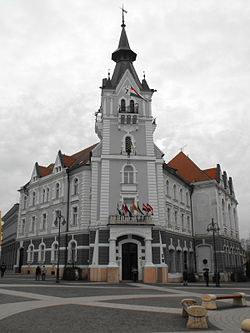
The City Hall of Kaposvár
After the years of thraldom, it seemed the development could start. The church was built up and the first guild was founded. But the beginning of the 18th century brought suffering and blows to the settlement instead the development. The Habsburgs in 1702 destroyed to the earth the Castle of Kapos. And the ruins were desolated during the Rákóczi's War of Independence.
But in the ruins some decades later a new country town was built. The resettlement of the city after the destruction, is in connection to the name of the Esterhazy family and the fortification of its economic and administrative rule. The city got the right for holding markets in 1703, in 1715 the first school was built up, in 1730 there was already 132 houses and a new church was ready in 1748. In 1749 Kaposvár was designated the county seat. In 1750 for good Kaposvár became the chief town of a county. More and more artisans and traders moved into the city and the number of the citizens during six decades doubled by 1780. During the 1800s the city developed considerably, due to the importance of the railway line between Buda and Zagreb. Kaposvár became an important industrial city.
But more important was that, so from the 19th century significant medical and cultural institutions were founded in Kaposvár. The "kis gymnasium" (the predecessor of the present Táncsics Mihály Secondary Grammar School), the Arany Oroszlán Pharmacy (Gold Lion) and the general hospital were built up, and we can found the name of Dániel Berzsenyi among the name of the County Library's readers, which was founded in 1816. The small county town started to become a civic town. The city center evolved with the county hall, the building of the town hall, the church, the Korona Hotel and the Dorottya-house. The National Casino of Kaposvár and the Horse Raiser Company were set up, and the visitors of Kaposvár could walk on paved roads. Earl István Széchenyi was elected to the first freeman of the town in 1835.
Revolution and War of Independence of (1848-1849)[]
The Hungarian Revolution of 1848 didn't avoid the chief town of Somogy county. The citizens voted for the revolution. Although the kaiser's groups occupied the city for a short time, they couldn't supple the insurrectionist Kaposvár. The local citizens still sacrificed the bell of the church to make cannon. The sheriff of Kaposvár, the later commissary, Gáspár Noszlopy with its territorial army, liberated Somogy county for three months. However the war of independence tumbled and Kaposvár got again under foreign occupation.
Austro-Hungarian Monarchy[]

The Convent
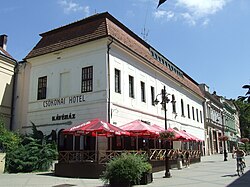
The Dorottya House (Csokonai Hotel)
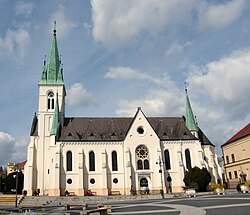
The Cathedral of Kaposvár

The Dorottya Hotel****
Although the oppression slowed down but couldn't stop the development. The post office opened, and the country's first soap factory was founded. And thanks for an Austrian growth brewer János Donner, a new city district - the present Donner - started to built in the south side of River Kapos. The local public life bloomed, after the casino the set up of the chorus, and then the first weekly newspaper in 1866, the Somogy started on its way with its editor, the famous journalist István Roboz. One of Kaposvár's most blossing time was after the conciliation. Thanks for mostly the railway building: until that time there were railroads only in the winger of the county, and the first engine arrived to Kaposvár in 1872. It opened the possibilities for the artisans and traders and the development of the city's economic life. In the years of 1890 the development of the infrastructure gave new movement to the city's development. Short train ways were built and they made the city for railway interchange. The railway network became wider, there were trying to bring in electricity, a telegraph office was created and they set up telephone connection with Pécs. At the beginning of the 1900 years there were already eleven big industrial companies in the city, among them the sugar factory from the autumn 1894, which was then one of the most significant plant in the country, and the MIR Malom grain processing plant. By this time the agricultural character of the city reduced. But there was another, new project: with the growth of the population's number the city became larger and larger. The first important planned city development is in connection with István Németh, who was the major of the city between 1895 and 1911. For the citizens their environment became more and more important and thanks for the Kaposvári Szépítő Egyesület (Kaposvári Beautifying Association), the city became then a real "flowered city".
The representatives of the culture had to keep step with the economic development. By that time the city has the right to keep high-school graduation in its secondary grammar school, there was a convent, a seminary and beside other institutions a day-nursery too. The first daily newspaper of the county, the Somogyi Hírlap came out from the printing-house in April 1904. In September 1911 the stone theater of Kaposvár was opened, which was then the country's biggest and modernest theater, where the most popular actors and actresses played. And a new cultural trend born, the film: in the first decade of the 20th century there were already three cinemas. Newer and newer cultural and art associations were founded. A lot of famous artists settled down there, like József Rippl-Rónai, Endre Ady, István Fekete and Aurél Bernáth.
20th century[]
The years of development ended with the start of World War I, in which - like in other important events of the Hungarian history - the citizens, the soldiers of Kaposvár took their part. But the war brought hardship and dissatisfaction to the city. In the public life there were strikes and strengthening of left-wing ideas. The ideas of the Revolutions and interventions in Hungary (1918–20) found place in the public life. The first directorium and agricultural association were born here and the plants were socialized. But the revolution fell and together with the war, the years of terror and the Treaty of Trianon brought a recession which from it slowly recovered from the years of 1930. Although the role of the railway transport diminished, bus transport started and in 1929 the airport was built in Taszár. From an industrial city Kaposvár became a commercial and administration center and the transformation of the cityscape reflected this change. It didn't just have flowers but was a clean, pleasant, civic town with restaurants, cafés and active cultural life. Thanks to József Adorján, Ferenc Csik and a number of olympic sportmen the world got to know the city's sportlife.
The national policy darkened more and more, the "happy peacetimes", the left-wing ideas and later the wind of the World War II reached the city. Almost one thousand citizens died or disappeared during the fights. In 1944 the city was twice under foreign occupation. In March the German soldiers filed in Kaposvár. The Jews were deported, most of them died in Auschwitz. The frontline arrived here on 2 December when soviet troops replaced the Germans.
The life could start fast in the city because fortunately, the fights didn't cause remarkable destruction. Kaposvár always said to be an "insurrectionist" city and it chose again the policy of restart. The parties formed, like the Communist Party, but the Country Party had the biggest side. After the communist received the power the socialisations finished and the new kind of industrial expansion started, the socialist industrialisation. Its result was for example the textile factory, meat plant, electricity factory. But the small industries disappeared. In 1956 Kaposvár joined the revolution but on 4 November the soviet tanks clunked through the city's streets: the fall of the revolution and the sanctions had a lot of victim in Kaposvár. Between them the famous born of Kaposvár, the revolution's martyr prime minister, Imre Nagy. The chief city of the county woke up hardly after the flop. In the next decade the development of the industry and the flat construction started. From 1970 new subtopias built. The city's administrative border flared: in 1950 Kaposszentjakab, in 1970 Kaposfüred and Toponár and in 1973 Töröcske joined the city. In 1971 the training-school and the agricultural technical institute became college. In the field of science and culture many person made famous the name of the city, not just in the country but beyond the borders too: the Archives of Somogy County, the Csiky Gergely Theatre, the Béla Vikár Choir, the Somogy Dance Group, and the Berzsenyi Company.
The crisis of the 1980s, and the stop of the city's development made necessary changes. In the end of the decade - like so many times during its history - Kaposvár stood to the top of reforms. The maverick organisations were funded and a memorial tablet was put on Imre Nagy's house, as the symbol of new times. In 1990 Kaposvár became urban county and in 1993 an episcopal seat.
21st century[]
Today Kaposvár - with its university, education system, and thousands of students - is a real school city. With the well-kept plazas, streets, colourful flowerbeds it is the city of flowers. With its rippling wells it is the city of waterworks. With its lively cultural life, rich art programmes it is the city of festivals and the city of painters. With its wonderfully reborn downtown with the feeling of peaceful, Mediterranean atmosphere, the chief town of the county has become a real European city.[1]
Main sights[]
- City Hall of Kaposvár
- Cathedral of Kaposvár
- County Hall of Somogy
- Rippl-Rónai Museum - one of the biggest museum of Hungary
- Rippl-Rónai Villa - the house of the painter József Rippl-Rónai
- Csiky Gergely Theatre - one of the most famous and the biggest theatre of Hungary
- Dorottya House
- Vaszary Gallery - former Gallery of Somogy
- Palace of Culture of Kaposvár (Szivárvány Kultúrpalota) - the home of the worldfamous Kaposfest every August
- Árpád Együd Cultural Community Centre
- Archives Of Somogy County
- Sport Museum of Somogy County
- St. Donat Chapel (Baroque, early 18th century)
- Ruins of Benedictine Monastery of Kaposszentjakab (Romanesque and Gothic)
- Arany Oroszlán Pharmacy (Gold Lion)
- Former Convent - now it is the Roman Catholic High School, Elementary School and Primary Art School and the headquarters of the Roman Catholic Diocese of Kaposvár
- Stadion Kaposvár Rákóczi
- University of Kaposvár
- Lake Deseda
- Virágfürdő (Flower Spa and Waterpark)
Famous people[]
- Szabolcs Balajcza
- Benjamin Balázs
- István Bank
- Lukács Bőle
- Győző Burcsa
- Ferenc Csik
- Zoltán Czibor
- Zoltán Farkas
- Zoltán Finta
- Péter Frankl
- István Gyenesei
- László Horváth
- Zoltán Jovánczai
- Moritz Kaposi
- Béla Király
- Béla Koplárovics
- Attila May
- Imre Nagy
- Viktor Petrók
- Anna Pfeffer
- Gábor Reszli
- József Rippl-Rónai
- László Sótonyi
- János Vaszary
- Róbert Waltner
Sports[]
Kaposvár is one of the National City of Sport in Hungary. The most popular sports in the city are football, volleyball and basketball. There are a lot of champion team in the city. The most famous sport team is the Kaposvári Rákóczi FC. Their home stadium is the Stadion Kaposvár Rákóczi. The biggest sporting event in the city is the Youth Football Festival every summer.
Population[]
| Historical population | ||
|---|---|---|
| Year | Pop. | ±% |
| 1850 | 4,638 | — |
| 1890 | 12,544 | +170.5% |
| 1900 | 18,630 | +48.5% |
| 1910 | 24,572 | +31.9% |
| 1920 | 30,096 | +22.5% |
| 1930 | 33,226 | +10.4% |
| 1941 | 33,515 | +0.9% |
| 1949 | 33,535 | +0.1% |
| 1960 | 43,428 | +29.5% |
| 1970 | 60,937 | +40.3% |
| 1980 | 72,374 | +18.8% |
| 1990 | 71,788 | −0.8% |
| 2001 | 68,697 | −4.3% |
| 2011 | 66,245 | −3.6% |
Kaposvár is the biggest city in Somogy County and one of the biggest cities in Transdanubia.
Demographics[]
- Population total: 67 979
- Area total: 113.59 km2
- Populationrank: 13th
- Population density: 598.23 /km2
Ethnic groups[]
| Ethnic group | % of total |
|---|---|
| Hungarians | 96.9 |
| Gypsies | 1.7 |
| Germans | 0.7 |
| Poles | 0.3 |
| Croats | 0.2 |
| Others | 0.2 |
Religions[]
| Religion | % of total |
|---|---|
| Roman Catholic | 63,9 |
| Calvinist | 7,2 |
| Lutheran | 2,0 |
| Atheist | 14,9 |
| Others | 1,8 |
| No answer, unknown | 10,2 |
International relations[]
Twin towns - Sister cities[]
Kaposvár is twinned with:
|
Gallery[]
See also[]
- University of Kaposvár
- Roman Catholic Diocese of Kaposvár
- Csiky Gergely Theatre
- Lake Deseda
References[]
- ^ "Kaposvár's history". http://www.tourinformkaposvar.hu/index.php?p=10&lang=en. Retrieved 2012-09-16.
- ^ "Bath's Twinning Associations". The Mayor of Bath. http://www.thecityofbath.co.uk/twinning-associations. Retrieved 2013-07-15.
- ^ "Town Twinning". Bath and North East Somerset Council. Archived from the original on 27 October 2007. http://web.archive.org/web/20071027142443/http://www.bathnes.gov.uk/BathNES/leisureandculture/tourismandtravel/Twinning/. Retrieved 12 December 2007.
- ^ "Mostar Gradovi prijatelji [Mostar Twin Towns]" (in Macedonian). Grad Mostar [Mostar Official City Website]. Archived from the original on 2013-10-30. http://web.archive.org/web/20131030103002/http://www.mostar.ba/gradovi-prijatelji.html. Retrieved 2013-12-19.
External links[]
- Official website
- Tourist Information
- Kaposfest
- Youth Football Festival
- Aerial photography: Kaposvár
- Slide show with music
- Video of the city centre
| |||||
| |||||||||||||||||
| ||||||||||
| This page uses content from the English language Wikipedia. The original content was at Kaposvár. The list of authors can be seen in the page history. As with this Familypedia wiki, the content of Wikipedia is available under the Creative Commons License. |



